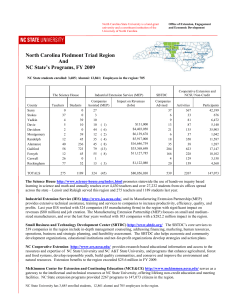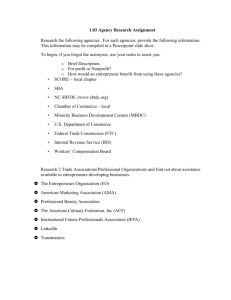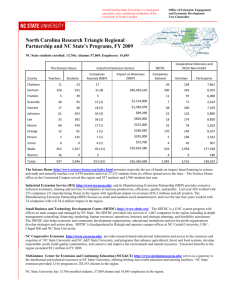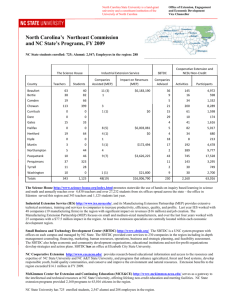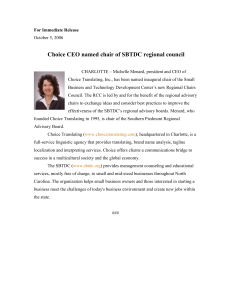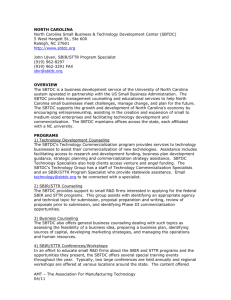North Carolina Southeast Region and NC State's Programs, FY 2009
advertisement
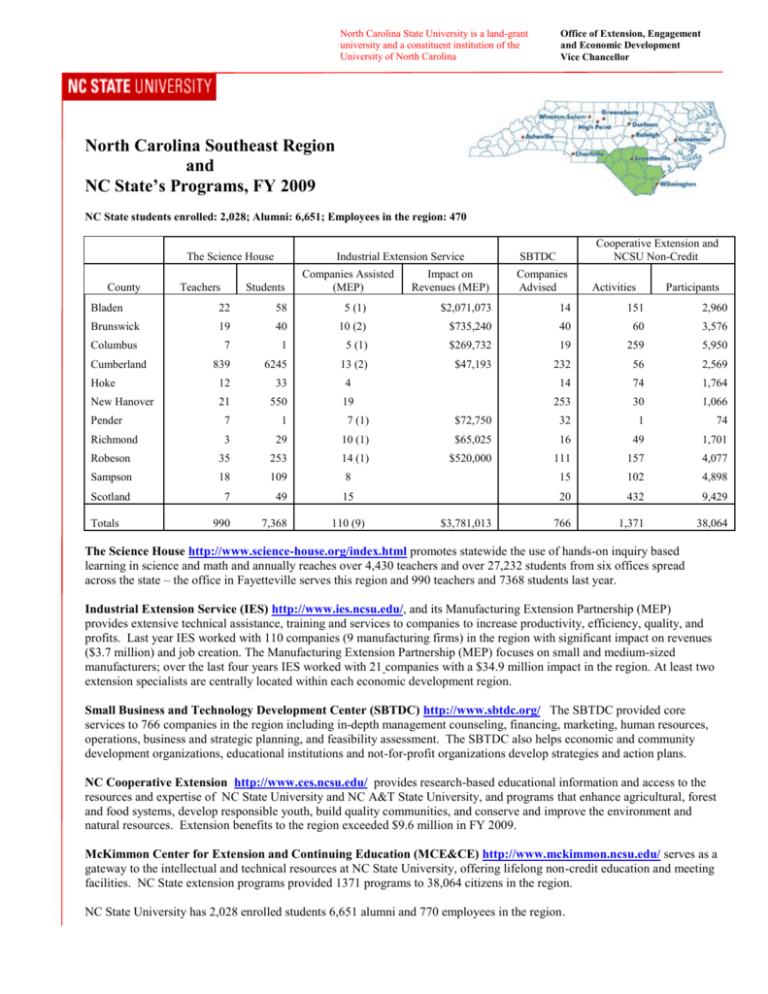
North Carolina State University is a land-grant university and a constituent institution of the University of North Carolina Office of Extension, Engagement and Economic Development Vice Chancellor North Carolina Southeast Region and NC State’s Programs, FY 2009 NC State students enrolled: 2,028; Alumni: 6,651; Employees in the region: 470 The Science House County Teachers Industrial Extension Service Students Companies Assisted (MEP) Cooperative Extension and NCSU Non-Credit SBTDC Impact on Revenues (MEP) Companies Advised Activities Participants Bladen 22 58 5 (1) $2,071,073 14 151 2,960 Brunswick 19 40 10 (2) $735,240 40 60 3,576 Columbus 7 1 5 (1) $269,732 19 259 5,950 839 6245 13 (2) $47,193 232 56 2,569 Cumberland Hoke 12 33 4 14 74 1,764 New Hanover 21 550 19 253 30 1,066 Pender 7 1 7 (1) $72,750 32 1 74 Richmond 3 29 10 (1) $65,025 16 49 1,701 Robeson 35 253 14 (1) $520,000 111 157 4,077 Sampson 18 109 8 15 102 4,898 Scotland 7 49 15 20 432 9,429 990 7,368 766 1,371 38,064 Totals 110 (9) $3,781,013 The Science House http://www.science-house.org/index.html promotes statewide the use of hands-on inquiry based learning in science and math and annually reaches over 4,430 teachers and over 27,232 students from six offices spread across the state – the office in Fayetteville serves this region and 990 teachers and 7368 students last year. Industrial Extension Service (IES) http://www.ies.ncsu.edu/, and its Manufacturing Extension Partnership (MEP) provides extensive technical assistance, training and services to companies to increase productivity, efficiency, quality, and profits. Last year IES worked with 110 companies (9 manufacturing firms) in the region with significant impact on revenues ($3.7 million) and job creation. The Manufacturing Extension Partnership (MEP) focuses on small and medium-sized manufacturers; over the last four years IES worked with 21 companies with a $34.9 million impact in the region. At least two extension specialists are centrally located within each economic development region. Small Business and Technology Development Center (SBTDC) http://www.sbtdc.org/ The SBTDC provided core services to 766 companies in the region including in-depth management counseling, financing, marketing, human resources, operations, business and strategic planning, and feasibility assessment. The SBTDC also helps economic and community development organizations, educational institutions and not-for-profit organizations develop strategies and action plans. NC Cooperative Extension http://www.ces.ncsu.edu/ provides research-based educational information and access to the resources and expertise of NC State University and NC A&T State University, and programs that enhance agricultural, forest and food systems, develop responsible youth, build quality communities, and conserve and improve the environment and natural resources. Extension benefits to the region exceeded $9.6 million in FY 2009. McKimmon Center for Extension and Continuing Education (MCE&CE) http://www.mckimmon.ncsu.edu/ serves as a gateway to the intellectual and technical resources at NC State University, offering lifelong non-credit education and meeting facilities. NC State extension programs provided 1371 programs to 38,064 citizens in the region. NC State University has 2,028 enrolled students 6,651 alumni and 770 employees in the region. Other Southeast Regional programs and Partnerships, and County NC State Programs SBTDC has offices at UNC Pembroke, Fayetteville State University, and UNC Wilmington. BRAC Region and Kenan Fellows: The Economic Development Partnership (EDP) has facilitated multiple meetings, presentations and strategy sessions between the Kenan Fellows Program and the BRAC Regional Task Force that resulted in a $1.5 million NSF Noyce II grant and 16 Kenan Fellowships in area schools to date. Funding is available to underwrite a total of 25 Kenan Fellows, expanding the STEM education commitment undergirding the education-workforce-economic development foundation in the NC Southeast Region. The EDP anticipates continued interaction with regional and local economic development leaders to sustain and expand the excellent working relationship that exists. Walt Wolfram’s linguistic research and the production of local, statewide, and national TV documentaries on language variation in North Carolina and on particular dialects includes Outer Bank English, Appalachian English, Lumbee English, and Hispanic English. Bladen: Cooperative Extension Service programs had a $3.1million impact of during 2008-2009 fiscal year. Brunswick: SBTDC served 40 businesses with 301 full-time employees and 278 part-time employees; these companies generated $23.5 million annual sales. Cooperative Extension’s program had a $2.6 million impact. Columbus: The Border Belt Tobacco Research Station (NCDA &CS) is in Whiteville, on which NCSU does research on tobacco, cotton, peanuts and soybeans. Cumberland: In partnership with Fayetteville State University, the Shelton Leadership Challenge Summer Institute provides a one-week summer experience for rising high schools students, freshman to seniors, with Shelton’s cornerstones of values-based leadership-honesty, integrity, social responsibility, diversity, and compassion. Hoke: SBTDC -14 businesses were served with business management, finance and marketing consulting; companies served generated sales of $15,063,000 and have 83 employees. New Hanover: The Industrial Extension Service worked with 3 companies over last four years with over $22 million impact and 104 jobs either created or saved. Pender/Sampson: The NC State Horticultural Crop Research Station is in Castle Hayne focuses on blueberries, grapes, strawberries, sweet potatoes, cucumbers, Irish potatoes, various ornamentals, greens, cabbage, cucurbits, and alternative crops and production methods as well as production methods for local markets. As a result, over 50 crop and animal producers in the county have implemented new practices resulting in a minimum of $50,000 in additional income. Richmond: With 4-H Science Adventures, over 550 fifth graders participated in a day of hands-on activities at Camp Millstone with experts in the natural sciences. Teachers reported that the project was a useful addition in helping them meet requirements of the North Carolina Standard Course of Study. All of the teachers saw increased student interest in science and 89% reported improvements in goal setting and study skills, with 100% noting increased problem solving and critical thinking skills following the program. Robeson: The Architectural School in the College of Design worked closely with the Lumbee tribe to develop residential designs that were respectful of the tribal cultural values and needs. Local companies built the homes for tribal members. Scotland: Over 3,000 pounds of unwanted pesticides were collected during a pesticide recycling day, saving county farmers $6,000. Thirty participants were involved in a grants writing workshop; 1 participant secured $146,000 in grants after the training.
